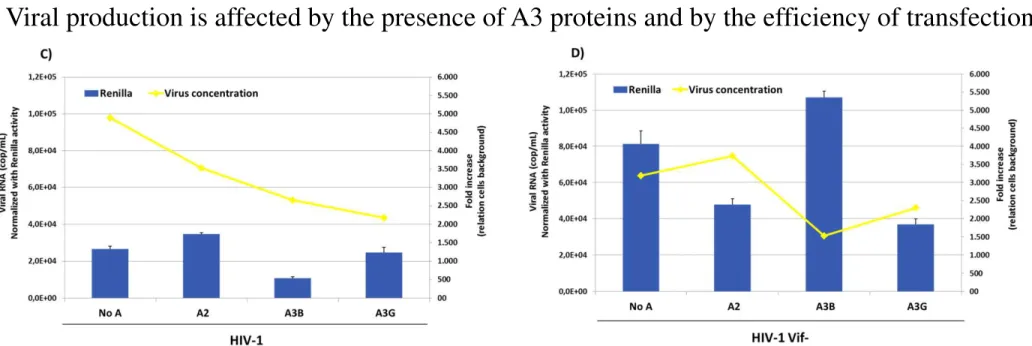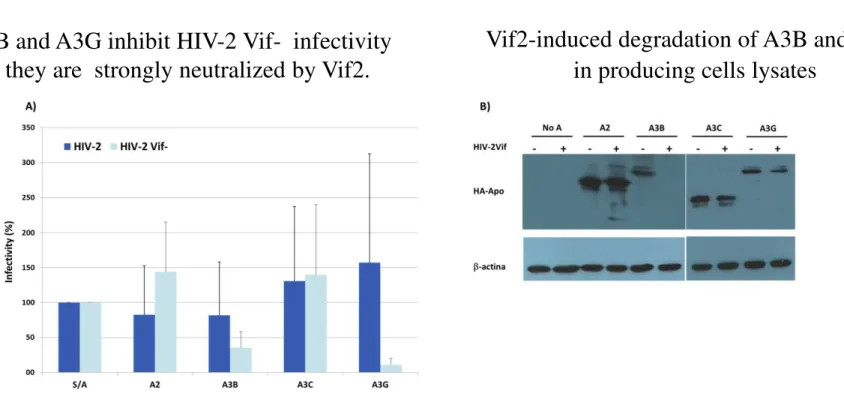Production and Infectivity of HIV-2
Bandarra S1,2, Ribeiro AC1, Gomes P1,3, Gonçalves J2, Barahona I1
1. Centro de investigação interdisciplinar Egas Moniz (CiiEM), Instituto Superior de Ciências da Saúde Egas Moniz, Caparica, Portugal; 2. Research Institute for Medicines (iMed.Ulisboa), Faculty of Pharmacy,
Several studies indicate that susceptibility to host factors could explain pathogenic differences between HIV-2 and HIV-1. Deaminases of APOBEC3 (A3) family, particularly A3G, have antiviral activity against HIV-1 which is suppressed by the viral protein Vif. Little is known concerning HIV-2 inhibition by the different members of the APOBEC3 family.
Probably HIV-2 and HIV-1 have differences in the threshold requirements for the same cellular factor or in the involvement of different factors to compensate for Vif1 and Vif2 functions2,3considering that :
- Vif2 and Vif1 share only 30% of identity
- Vif2-induced degradation of A3 proteins is different from the one previously observed by Vif1.1
- HIV-2 and HIV-1 vif defective viruses produced in different T-cell lines showed differential replication and capacity for productive infection
Review and Aims
Methods
Methods
Results
Viral production of HIV-1 is higher than HIV-2 production in 293T cells transfected with the same amount of DNA.
Infectivity detection system used has a higher discriminatory power for HIV-1 infections.
Results
Viral production is affected by the presence of A3 proteins and by the efficiency of transfection. In the presence of A3 proteins, HIV-2Vif- production decreases drastically.
Results
Fig. A3 proteins inhibit viral production of HIV-1 (C) and HIV-1 vif- (D) pRL.CMV (Renilla expression vector) it was used as a transfection efficiency control of 293T producing cells . Values of Renilla activity are presented as n fold in relation to cell background (secondary axis). Produced viral levels (cop/mL) were normalized with values of transfection efficiency control determined in the producing cell lysates for each condition. Porque mudou o tipo de letra?
Results
A3B and A3G inhibit HIV-2 Vif- infectivity and they are strongly neutralized by Vif2.
Fig. 3 A) Viral infectivity of HIV-2wt and HIV-2Vif- produced in the presence of different APOBEC. After virus normalization, A3 antiviral effects were evaluated by one cycle infectivity assay in TZM-bl cells. Values are presented as % of infectivity relative to viruses produced in the absence of A3, defined as 100% (empty vector was used as control). Columns and error bars represent average± SD, respectively (n=2);B) Sensitivity of A3 proteins to Vif2. Representative Western blot of A3 proteins in virus-producing cells lysates.
Conclusions
In transfected 293T cells HIV-1production is higher than HIV-2 production.
Viral production is affected by the presence of A3 and by the efficiency of transfection.
This effect is more pronounced in HIV-2Vif- productions.
HIV-2 infectivity is strongly inhibited by A3B and A3G and this antiviral effect is efficiently
suppressed by Vif2 protein.
References
[1] Smith, J.L., et al., (2014)Journal of Virology, 88(17), p. 9893-9908 [2] Reddy, T.R., et al., (1995) Journal of Virology, 69(6), p. 3549-3553. [3] Ribeiro, A.C. et al., (2005) Journal of Virology, 79, p.823-833.



